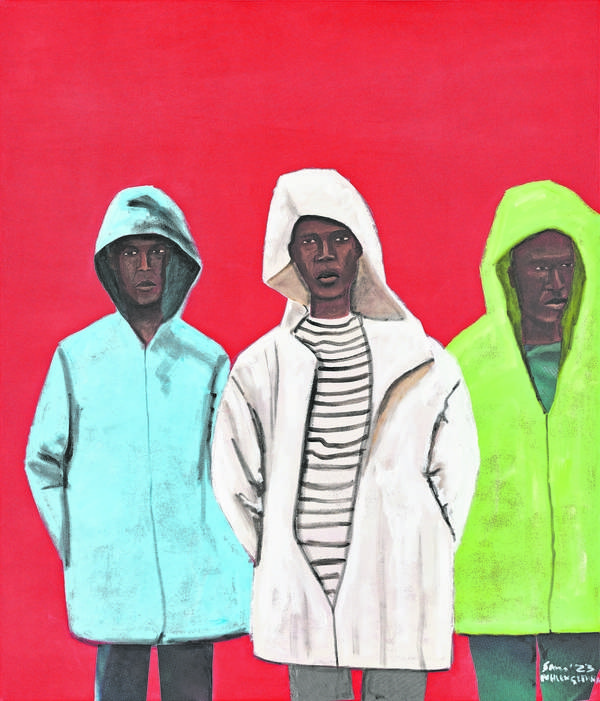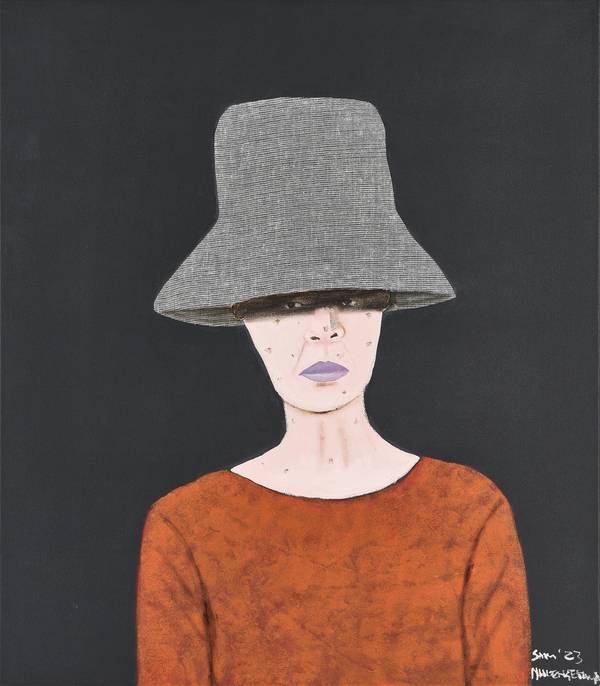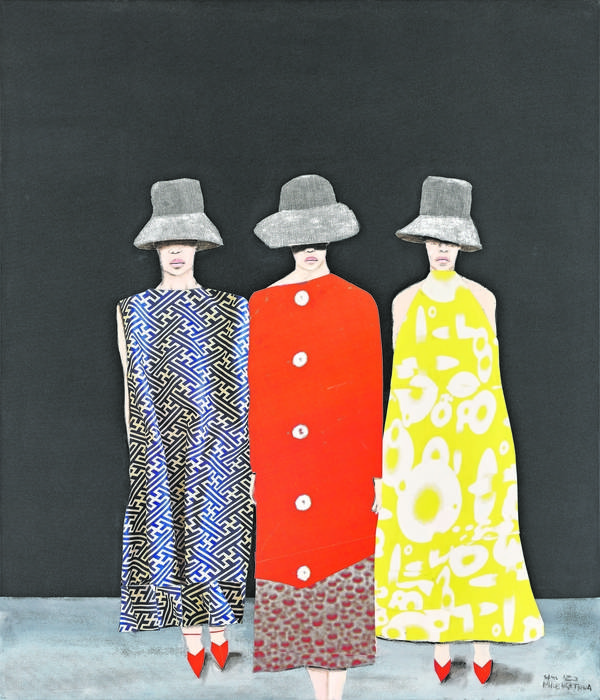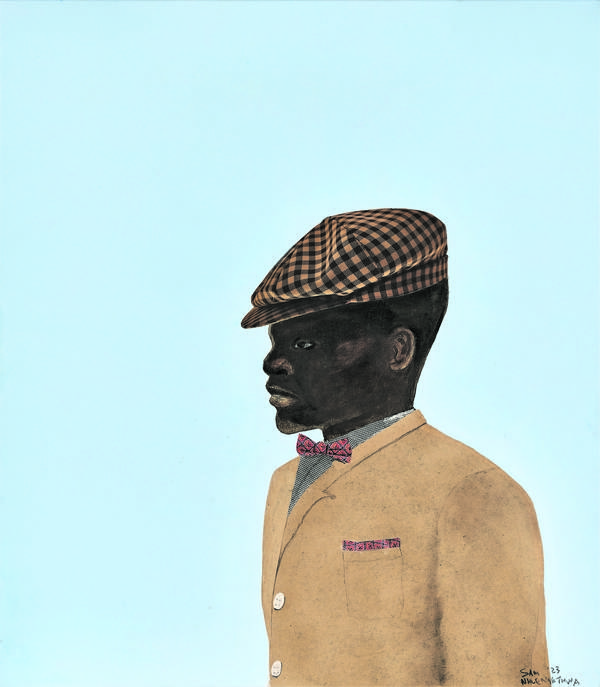

Even in paint-spattered clothes — denim Bermudas and a worn pink linen shirt — and on the hottest day of a suffocating Highveld heatwave, Sam Nhlengethwa exudes cool.
The 68-year-old artist is riffling through a floor-to-ceiling record shelf looking for a Sammy Davis Jr album he has been telling me about.
We are in the airy, L-shaped, open-plan living room of his spacious house, on a sprawling Benoni smallholding.
To our left is a large painting of Malian singer Salif Keïta waiting on an easel.
To the right an equally substantial, and also nearly completed, one of Sade, the British soul singer.
But these two works won’t feature in Nhlengethwa’s latest exhibition of new paintings and prints at the Goodman Gallery in Johannesburg, because as the title says, the show is about Art Meets Fashion.


So, we are talking clothes, colours and models. And about that elusive pink cardigan jazz fan Nhlengethwa was reminded of the other day when he was listening to the record he is handing to me, Sammy Davis Jr Belts the Best of Broadway, with its striking cover.
“He looks so good. He’s wearing a white Arrow shirt and a pink cardigan,” Nhlengethwa says, “and for a long time, I wanted to dress like that, but I can’t get the pink cardigan.
“Even when I go overseas, I ask at shops, ‘Can I get the cardigan in a pink colour?’ but no luck.”
Nhlengethwa is a chronicler of everyday life in South Africa, from city life in Jo’burg to domestic spaces, and, of course, jazz. It is no surprise that fashion now features on his canvases, because many jazz musicians are known for their suaveness and sartorial expression.
“I also like the way Ray Charles used to dress up. And the Modern Jazz Quartet. Even Duke Ellington.”
But it goes way back for this fifth-born in a family of eight children.
“I’ve been a fan of fashion for as long as I can remember — as a teenager, because of my 10-years-older brother Mxolisi, who’s the second in the family. He’s been a very trendy person. He’s the one who opened my eyes to fashion.”
Nhlengethwa takes us on a trip down the fashion lanes of Joburg circa the 1970s, when as a debonair, late-teenage trendy himself, he wore brands such as Florsheim, Haspel, Bass, Arnold Palmer but, as a gentleman, not Dobshires — “They were associated with mapantsula,” the painter explains.
It was a time when shops such as Lightbody’s, Strachan & Myburgh, Kruger’s and John Craig were packed with folks from the black townships on Saturdays.
But he especially remembers the American Showroom where “the gentleman who was running it, a Jewish guy, was a true salesman knowing how to run his business. He would fit a pair of shoes and he says, ‘You are the only one — I just got one pair.’ And you feel good.”
Wearing quality clothes and shoes wasn’t only about looking or feeling good, but like so much in apartheid South Africa, also profoundly political.
“It’s like pride, black pride … you could show the middle finger to them so, in that way, clothes were very political.”
The roots for the new exhibition go back to the late 1980s when Nhlengethwa collaborated with fashion designers in the Carlton Centre.
“They made a limited edition of these linen dresses and I painted over them with acrylic paint.”


And then a designer from Trinidad sold his wife, Maureen, a dress. Nhlengethwa recalls: “My wife was going to a function, and she said, ‘Does this dress look okay with these yellow sandals?’
“I said, ‘It’s a lovely dress but it needs that spark. Let me just take a yellow brush to play.’ She was showing that dress to someone the other day and said: ‘My husband did this 15 years ago and I still love it.’”
He goes to turn the record over — we are listening to Don Cherry’s free jazz masterpiece Brown Rice.
He comes back with another lovely story about his journey with fashion and art, this time about his daughter Ofentse, who is a student at Wits.
“She could have been 11 months old and my wife bought her some beautiful, soft leather shoes. And it had leather stitched onto it, in the shape of a flower. And I said, ‘These people didn’t finish that.’
“So, to make it colourful, I started to paint the petals yellow and then red inside the stigma.
“Those shoes are still here. She still loves them. ‘This is my first present of an artwork from my daddy,’ she says.”
For Art Meets Fashion, Nhlengethwa is collaborating with designer Sonwabile Ndamase — famous for his Madiba shirts —who is to produce a new collection inspired by the paintings.
With his deep-rooted sense of justice, Nhlengethwa is using his practice to platform those in society who are often overlooked.
For this show, the artist has people with albinism as the central figures in his works and is collaborating with motivational speaker, wellness coach and entrepreneur Palesa Mosiea to showcase their radiance.
“People often assume having a specific condition limits you,” she says in a press statement from the gallery. “I am excited to collaborate on this project given its aims to raise awareness about the challenges we face as people with albinism but also to positively demonstrate what we can do.”
For the opening night, there will be 12 young models with albinism — eight girls and four boys — exhibiting the clothes designed by Ndamase.
This show will be recorded so that visitors who attend the exhibition that will be on until 20 January can see it too.
Among the works are some of fashion models on ramps.
Did you go to fashion shows for this, I ask him.
“No.”
“You’re not a fashion show kind of guy,” I chuckle.
“No,” he smiles. “What I did was, like, there are many books and magazines in the house. I started to really look at them.
“Then there’s a TV show The Streets of Milan. My daughter introduced me to it. So, I used to watch that. And that helped me. That gave me inspiration.”
But it is not only haute couture portrayed in his paintings and prints. He also paid homage to street fashion, the kind that made a young Nhlengethwa proud of himself and proud of his people.
“I just allowed any form of inspiration that comes in,” he tells me before I go. “I must make use of it.”
It’s Friday afternoon and the works for Art Meets Fashion are at the gallery already, a week early.
Nhlengethwa is going to open the patio doors to the garden, light a well-deserved cigar and, of course, listen to jazz.
The post Fashioning meaning in art appeared first on The Mail & Guardian.
Artist and jazz fan Sam Nhlengethwa’s new show has roots in his interest in clothing
The post Fashioning meaning in art appeared first on The Mail & Guardian.



